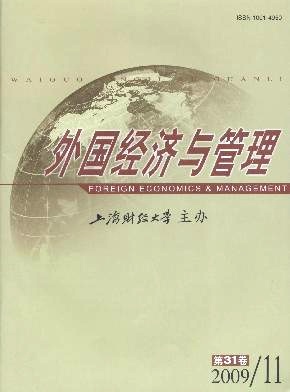企业间关系结构及其共生演化研究
外国经济与管理 2009 年 第 31 卷第 11 期, 页码:29 - 37
摘要
参考文献
摘要
本文基于关系灵活性视角把企业间关系结构划分为权力科层结构、交易耦合结构和协同网络结构,从规制方式、权力依赖、关系复杂性、关系重要性、关系变革等五个维度探讨了三种关系结构的核心内涵及其特征;然后构建了企业间关系结构共生演化的动力模型,并认为在内核驱动力、产业推动力和市场拉动力的共同作用下,企业间关系结构的共生演化会形成一种高度复杂化、差异化且具有低成本优势的多维结构。这种在波特实体企业竞争战略框架下看似无法实现的整合机制,在本文以PC行业为例的企业间关系分析中得到了验证。
[1]Kay,J.Why firms succeed[M].Oxford:Oxford University Press,1995.
[2]Baer,DJustine.Strategy and structure ininterfirmalliances:The U S biotechnology industry,1980-1992[D].University of Wash-ington,2002.
[3]Barringer,R Bruce,and Jeffrey S Harrison.Walking a tightrope:Creating value through interorganizational relationships[J].Journal of Management,2000,26(3):367-403.
[4]Williams,T.Cooperation by design:Structure and cooperation in interorganizational networks[J].Journal of Business Research,2005,58(2):223-231.
[5]Burt,S Ronald.Structural holes[M].Cambridge,MA:Harvard University Press,1992.
[6]姜翰,金占明.企业间关系强度对关系价值机制影响的实证研究[J].管理世界,2008,(12):114-125.
[7]Goliclic,L Susan,and John T Mentzer.Exploringthe drivers of interorganizational relationship magnitude[J].Journal of Business Lo-gistics,2005,26(1):47-71.
[8]Henrik,Sornn-Friese.Interfirmlinkages and the structure and evolution of the Danishtruckingindustry[J].Transportation Journal,2005,44(4):10-26.
[9]郝斌,任浩,吴轶轮.信息技术对企业间关系结构的影响:基于产业视角的分析[J].外国经济与管理,2009,31(3):9-15.
[10]Schilling,M A,and H K Steensma.The use of modular organizational forms:An industry-level analysis[J].Academy of Manage-ment Journal,2001,44(10):1149-1169.
[11]Afuah,A.Redefining firmboundaries in the face of the Internet:Are firms really shrinking[J].Academy of Management Review,2003,28(1):34-53.
[12]华彦玲.权威创造权力——一个理论拓展[J].经济评论,2009,(2):27-30
[13]Mudambi,R,and S Helper.The“close but adversarial”model of supplier relations in the US auto industry[J].Strategic Manage-ment Journal,1998,19(5):775-792.
[14]Gulati,R,and MSytch.Does familiarity breed trust-Revisiting the antecedents of trust[J].Managerial and Decision Economics,2008,29(1):165-190.
[15]Orton,J D,and K E Weick.Loosely coupled systems:Areconceptualization[J].Academy of Management Review,1990,15(2):203-223.
[16]郝斌,任浩.设计竞争与设计演化——以汽车产业为例[J].财贸研究,2008,(4):97-104.
[17]Baldwin,Y Carliss,and Kim B Clark.Design rules:The power of modularity[M].Cambridge,MA:MIT Press,2000.
[18]Sahaym,A,Steesma,H K,and M A Schilling.The influence of information technology on the use of loosely coupled organizational forms:Anindustry-level analysis[J].Organization Science,2007,18(5):865-880.
[19]藤本隆宏.能力构筑竞争——日本的汽车产业为何强盛-[M].北京:中信出版社,2007.
[20]Zaheer,A,and G Bell.Benefiting fromnetwork position:Firmcapability,structural holes,and performance[J].Strategic Manage-ment Journal,2005,26(5):809-825.
[2]Baer,DJustine.Strategy and structure ininterfirmalliances:The U S biotechnology industry,1980-1992[D].University of Wash-ington,2002.
[3]Barringer,R Bruce,and Jeffrey S Harrison.Walking a tightrope:Creating value through interorganizational relationships[J].Journal of Management,2000,26(3):367-403.
[4]Williams,T.Cooperation by design:Structure and cooperation in interorganizational networks[J].Journal of Business Research,2005,58(2):223-231.
[5]Burt,S Ronald.Structural holes[M].Cambridge,MA:Harvard University Press,1992.
[6]姜翰,金占明.企业间关系强度对关系价值机制影响的实证研究[J].管理世界,2008,(12):114-125.
[7]Goliclic,L Susan,and John T Mentzer.Exploringthe drivers of interorganizational relationship magnitude[J].Journal of Business Lo-gistics,2005,26(1):47-71.
[8]Henrik,Sornn-Friese.Interfirmlinkages and the structure and evolution of the Danishtruckingindustry[J].Transportation Journal,2005,44(4):10-26.
[9]郝斌,任浩,吴轶轮.信息技术对企业间关系结构的影响:基于产业视角的分析[J].外国经济与管理,2009,31(3):9-15.
[10]Schilling,M A,and H K Steensma.The use of modular organizational forms:An industry-level analysis[J].Academy of Manage-ment Journal,2001,44(10):1149-1169.
[11]Afuah,A.Redefining firmboundaries in the face of the Internet:Are firms really shrinking[J].Academy of Management Review,2003,28(1):34-53.
[12]华彦玲.权威创造权力——一个理论拓展[J].经济评论,2009,(2):27-30
[13]Mudambi,R,and S Helper.The“close but adversarial”model of supplier relations in the US auto industry[J].Strategic Manage-ment Journal,1998,19(5):775-792.
[14]Gulati,R,and MSytch.Does familiarity breed trust-Revisiting the antecedents of trust[J].Managerial and Decision Economics,2008,29(1):165-190.
[15]Orton,J D,and K E Weick.Loosely coupled systems:Areconceptualization[J].Academy of Management Review,1990,15(2):203-223.
[16]郝斌,任浩.设计竞争与设计演化——以汽车产业为例[J].财贸研究,2008,(4):97-104.
[17]Baldwin,Y Carliss,and Kim B Clark.Design rules:The power of modularity[M].Cambridge,MA:MIT Press,2000.
[18]Sahaym,A,Steesma,H K,and M A Schilling.The influence of information technology on the use of loosely coupled organizational forms:Anindustry-level analysis[J].Organization Science,2007,18(5):865-880.
[19]藤本隆宏.能力构筑竞争——日本的汽车产业为何强盛-[M].北京:中信出版社,2007.
[20]Zaheer,A,and G Bell.Benefiting fromnetwork position:Firmcapability,structural holes,and performance[J].Strategic Manage-ment Journal,2005,26(5):809-825.
引用本文
郝斌, 任浩. 企业间关系结构及其共生演化研究[J]. 外国经济与管理, 2009, 31(11): 29–37.
导出参考文献,格式为:





 5911
5911  270
270

